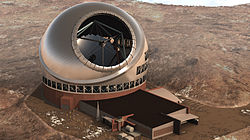
A segmented mirror is an array of smaller mirrors designed to act as segments of a single large curved mirror. The segments can be either spherical or asymmetric (if they are part of a larger parabolic reflector [1] ). They are used as objectives for large reflecting telescopes. To function, all the mirror segments have to be polished to a precise shape and actively aligned by a computer-controlled active optics system using actuators built into the mirror support cell.
Contents
- Application
- Telescopes using segmented mirrors
- Keck Telescopes
- Hobby-Eberly Telescope
- Southern African Large Telescope
- Gran Telescopio Canarias
- LAMOST
- James Webb Space Telescope
- Next-generation telescopes
- Diffraction spikes
- See also
- References
- External links
The concept was pioneered by Guido Horn D'Arturo, who built the first working segmented mirror in 1952, after twenty years of research; [2] It was later independently rediscovered and further developed under the leadership of Dr. Jerry Nelson at the Lawrence Berkeley National Laboratory and University of California during the 1980s[ citation needed ], and since then all the necessary technologies have spread worldwide to the point that essentially all future large optical telescopes plan to use segmented mirrors.












